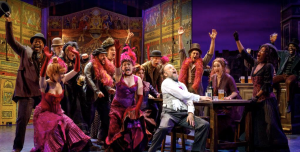By Pantho Sayed
We have all taken things for granted. Some things are so common in our daily lives that we stop noticing them. It is only when they do not work or are completely gone that we realize their importance.
Take language, for example. Sure, we read and write most of the time. But our most important communication is verbal. Speaking to each other connects us not just from the words themselves, but from the way they are spoken. We each have unique speech patterns, voice inflections and catchphrases. Sarcasm, emotion and volume are just a few aspects of oral language that do not translate well in writing. There is just something special about speaking to someone as opposed to writing to them.
Verbal communication is the matter at hand in the musical My Fair Lady. This performance in particular was at the Lincoln Center Theater in Vivian Beaumont. Set in early 20th century England, the plot centers on Eliza Doolittle, a poor slum-dwelling flower-seller with a strong Cockney accent. She encounters phonetics professor Henry Higgins, who teaches her how to speak proper English hoping to pass her off as a real lady.
My Fair Lady is surprisingly funny. There are many comedic moments and the entire musical is filled with irony. There are moments where the play makes fun of itself as well.
The play shines most in its characters. Each one of them is memorable and unique in their own way. The playbill stated that this showing had a few cast changes and a majority of these actors and actresses were amazing in their own right. The normal leads must be unimaginably talented.
Actor, Henry Higgins was played phenomenally. Higgins is selfish and praises himself in songs like “I’m an Ordinary Man” and “A Hymn to Him” and describe the virtues of men, in juxtaposition to his complete misogyny and elitism.
Another surprisingly great character was Alfred Doolittle, Eliza Doolittle’s father. Like Eliza, he is poor and a slum dweller, but spends all his money on alcohol. His lines and actions are wild and zany, and his own story arc served as a nice interlude between the main plot.
Eliza Doolittle herself was very talented. Her singing was pleasant and the transition from “lower class” to “upper class” English was well done. She provided great energy and a buoyant air into all her scenes.
My Fair Lady also had a wonderful set. Early 20th century England was very well realized and vividly brought to life. From the slums and taverns to upper class housing and wealthy social functions, each scene and backdrop had its own unique personality.
The satirical nature of the play was also very well expressed here. Each social class area was overdone and the characters either very rambunctious or overly pretentious.
The stage props were created well. It was especially impressive when the tavern opened up in one scene. The most impressive prop was Higgin’s house, which was like a giant dollhouse with six to eight rooms and a staircase. It was exquisitely decorated with fine paintings, desk stationery and furniture.
The most important aspect of a musical is the music. The orchestra was outstanding; they never overshadowed the actors and actresses but played to fill the theater and reach the back seats. Each song felt distinct, but all were upbeat and lively with only a tinge of bitter sweetness or sorrow. The music highlighted conflict or changes in the tone suddenly and very effectively.
The lighting was fairly well done. Although there were a few mishaps, the spotlight always remained on the lead actor during a monologue and widened well to include the company during larger scenes. It was never too bright or too dark.
All in all, My Fair Lady is an entertaining play. There was almost always something to laugh about, whether in the satire of English culture or the folly of almost every single character.
My Fair Lady also had its tender moments. Characters like Higgins, Doolittle and others realize their own shortcomings as they come to grow as people. The conflict in the play is not between families or states, but over the relationships we make and how we view and interact with others from all walks of life. That is something everyone could use a lesson in.





































































































































































































